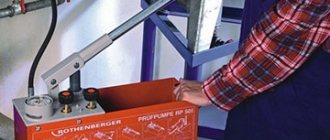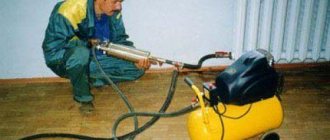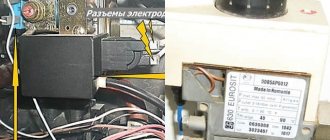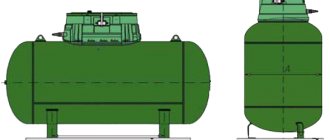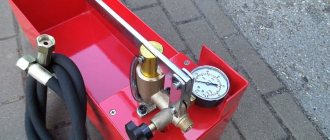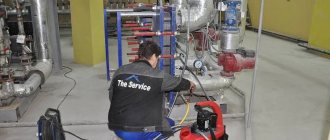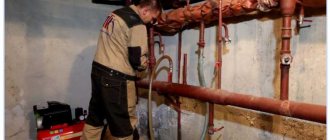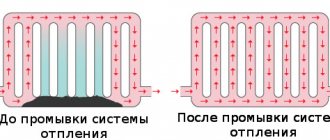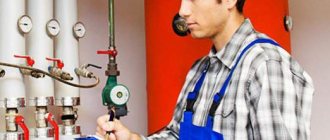Pipeline depressurization is an extremely undesirable phenomenon that can lead to very serious consequences.
To minimize the risk of such incidents, it is necessary to ensure that the system is sufficiently reliable before putting it into operation.
A special procedure will help you do this - pressure testing of the pipeline.
Pressure testing with air and water - what is it?
The essence of pressure testing is to fill a certain system with a closed volume - a pipeline, container, machine or mechanism - or its isolated section with a medium whose pressure is 2 - 3 times higher than the working one and almost corresponds to the maximum permissible value (the value of the test pressure for each specific case is set by the appropriate norms).
If the object passes this test, it is considered suitable for use.
Otherwise, places where the system has leaked are identified and repaired.
To create the required pressure, either a special pump for pressure testing pipelines, the so-called pressure tester, or a standard one, for example, a circulation pump in a centralized heating system, is used.
Water is usually used as a working medium, but if for one reason or another its penetration outside the tested system is unacceptable, pressure testing is carried out with air. In this case, leak locations are more difficult to detect.
Pressure testing is a fairly serious undertaking and must be carried out by a specially trained, certified employee. For municipal and industrial enterprises this rule is mandatory.
Upon completion of the procedure, a Certificate of hydropneumatic testing of the system (pressure testing of the pipeline) is signed, indicating the date, pressure value, holding time and other information.
As for private housing, the decision here is in the hands of the homeowner. Many people undertake crimping on their own, but it is still better to entrust this work to a professional.
Test Tools
To test the system for resistance to high pressure, a special device is used, which is called a pressure tester. It is a pump capable of creating pressure inside the system up to 60 or 100 atmospheres, depending on the type of mechanism. There are 2 types of pumps: manual and automatic. They differ only in that the second option stops pumping itself if the pressure reaches the desired level.
The pump consists of a tank into which water is poured and a plunger pump with a handle that moves it. On the body of the mechanism there are taps to block the pressure supply and pressure gauges to regulate the pressure. There is also a tap on the tank that allows you to drain the water that remains in the tank.
The principle of operation of such a pump is similar to a conventional piston analogue, which is used to inflate tires. The main difference is the cylindrical piston made of steel. It is fitted tightly inside the housing and a minimum gap is created, which makes it possible to pump up pressure up to 60 atmospheres.
Manual blower Source amazon.com
For hand pumps, the biggest disadvantage is that such pressure testing of pipes will take a very long time due to pumping the system with water. This process can take several hours, since large systems that have radiators will need to be filled manually.
Automatic devices work on a similar principle, but when the pressure limit is reached, they turn off themselves. They also require electricity to operate, so manual ones are more suitable for places where there is no power supply yet. Automatic pumps can pump pressure up to 100 bar, and industrial devices up to 1000 bar.
Electric version of the compressor Source ngenix.net
See also: Catalog of house projects with a boiler room up to 1 million rubles
When is crimping necessary?
Pressure testing is performed in the following cases:
- Before putting the system into operation for the first time.
- After repairing the pipeline or replacing any of its components.
- After a long period of inactivity (a typical example is heating pressure testing after the summer season).
- If a scheduled check of the system status is provided. For example, sewerage from polymer pipelines is subjected to periodic pressure testing in order to check their integrity.
- Also, pressure testing should be carried out after flushing the pipeline, especially if aggressive chemicals that can weaken the walls of pipes and fittings were used. The same applies to sewer cleaning, since during this operation the joints of the pipelines may be damaged.
There is a special type of pressure testing that is applied to water wells. This check allows you to determine whether the perched water is getting into the wellbore from where water is drawn.
Why is the pressure test procedure necessary?
During operation, scale and deposits of various salts accumulate on the walls of pipes, as well as batteries, as a result of which their diameter is reduced by almost half. Such incorrect operation leads to the following changes:
Read also: Sabantuy, the main Tatar holiday
- Rapid wear;
- Reduced heat transfer level;
- The pressure in the pipes drops significantly;
- Utility costs increase;
- A pipe rupture with all the ensuing consequences is possible.
In turn, the main heating indicators change. This leads to operating efficiency falling and costs rising. Therefore, pressure testing of the heating system plays a significant role in uninterrupted operation. After all, pipes that are clogged with scale very often lead to emergency situations. In order to avoid the above problems, crimping must be carried out:
- After installation is completed;
- Upon commissioning of the facility;
- After repair of the boiler, connecting units;
- When replacing worn or damaged parts;
- Before the start of the heating season.
Pressure testing of the heating system
For normal and uninterrupted heating operation, flushing must be carried out at least once a year before the start of the heating season.
Preparatory measures for crimping
Before starting crimping work, you must perform the following steps:
- The pipeline system under test is inspected for obvious defects (missing elements, rusted areas, etc.). Identified violations are eliminated. If the system is filled with any substance that cannot be used for testing, for example, coolant in a heating system, it must be emptied.
- Next, according to the rules, the pipeline is flushed. This operation will remove scale, rust, and organic and inorganic deposits from the pipes. Flushing can be carried out in various ways, some of which require the use of a compressor. According to the rules, upon completion of this procedure, the quality of its implementation should be checked by cutting out a section 0.5 m long in an arbitrary place of the pipeline and assessing the condition of its internal surface.
- The preparatory stage ends with the installation of a check valve and a pressure gauge, if they are not part of the injection device. A check valve is necessary to retain the working medium in the system.
When testing heating systems of apartment buildings, work on preparing the heating unit is carried out separately from the entire system and after it. This is due to the fact that this unit is tested with a higher pressure value.
Hydraulic testing services
If the heating system is installed by a contractor during the construction of a new home, then the responsibility for pressure testing of pipelines lies entirely with the contractor.
In the case when the heating system is already functioning, regardless of whether it is a residential building, a municipal institution, a shopping or office complex, pressure testing is carried out by an organization that services all systems of the building. In housing construction, the law provides for the responsibility of the management company to maintain heating systems in working order, and, consequently, to carry out measures to prepare for the heating season.
For administrative and other complexes, testing of systems is carried out either by the operating organization or by a contractor who has all the necessary permits to carry out a complex of work.
Crimping machines, pumps for crimping pipes
First of all, the pumps used for pressure testing differ in the design of the discharge mechanism.
On this basis they are divided into the following groups:
- Piston.
- Vane-rotor.
- Membrane.
For crimping systems with a small volume, for example, heating circuits in private homes, you can purchase an inexpensive and easy-to-maintain manual crimping machine.
Using such a device, the operator will be able to pump up to 3 liters of working fluid per minute into the pipeline. For a multi-storey building, this option, of course, will be unacceptable; here you will need a crimping machine with an electric or internal combustion engine drive.
The most popular is the domestically produced manual crimping machine UGO-30, designed for a maximum pressure of 30 atm. The cylinder volume is 36 cubic meters. cm, force on the handle – 2 kg. Equipped with a 16 liter tank.
For more serious tasks, manual two-stage pumps UGO-50 (up to 50 atm) and UGI-450 (up to 450 atm) are intended.
Manual hydraulic crimping machine UGO 30
Among electric crimpers, units from the German company Rothenberger are known, for example, the self-priming model RP PRO II, which develops a pressure of 60 atm and a flow of 8 l/min. The drive power is 1.6 kW.
Ridgid products are also highly rated, for example, model 1460-E. This crimping machine develops pressure up to 40 atm.
The autonomous water supply system will operate uninterruptedly only if the pressure switch for the hydraulic accumulator is correctly configured. Let's consider the principle of operation and the procedure for adjusting the relay.
Read how to make a drainage well with your own hands here.
Who doesn't dream of a swimming pool in their country house? Such a custom-made design will be expensive, but you can save money and build a pool yourself. Here https://aquacomm.ru/vodosnabzenie/zagorodnyie-doma-v/bassejn-na-dache-svoimi-rukami.html you will find instructions for building a concrete reservoir.
Flushing heating systems
Hydropneumatic flushing of heating systems is a mandatory measure when preparing the heating system for start-up before the start of the heating season.
Water circulates through a closed circuit of the heating system during the heating period, and when heated and cooled, hardness salts are deposited. And this, together with the processes of corrosion of the internal walls of the pipes, leads to the deposition of scale on them. Scale significantly reduces the internal cross-section of pipelines, increases the hydraulic resistance of the system and reduces the heat transfer of radiators.
In high-temperature heating systems, scale leads to local overheating and further formation of fistulas. Scale deposits one millimeter thick lead to a reduction in heat transfer from the heating system by 15-20%. And on a global scale, this means colossal losses of thermal power and a significant decrease in the energy efficiency of the system with a significant increase in the cost of heating the building.
Flushing heating systems is the same necessary annual event as pressure testing, and is carried out before the start of the heating season or at the time of commissioning.
The main sign of a “clogged” heating system is an increase in coolant consumption, an increase in warm-up time, or uneven heating of the radiators. In these cases, situations often arise when the pipelines are hot, but the radiators are not yet warmed up.
The hydropneumatic method involves filling the system with clean water and connecting an air compressor to it. Excessive air pressure increases the flow rate of the coolant and creates turbulent fluid flows. These flows in places of scale deposits create vortex vibrations, as a result of which contaminant particles are torn off the surface of the walls.
When supplying high pressure air, the valve on the air bleed valves must be closed, and a check valve must be installed to protect the compressor from water entering the system.
Also, for flushing the system, there are special solutions that break down the scale deposited on the walls of pipelines and thereby reduce their hydraulic resistance.
How it's done?
The general scheme of hydropneumatic tests is as follows:
- The part of the system being tested is isolated by shutting off the shut-off or control valves (the sewer pipes are closed with rubber plugs or wooden plugs wrapped in rags).
- Next, the system is completely filled with water. In the heating system, air is released through air vents installed at the very top.
- A pressure testing pump is connected to the pipeline, which pumps a certain amount of working fluid into the system, creating the pressure required by the test regulations.
- When the required pressure is reached, the pressure tester switches off. In this case, the observer records the readings on the pressure gauge.
- The system remains under pressure for a certain period of time. The exposure time can range from 0.5 hours (for heating systems) to 6 – 8 hours.
- After the appointed time has expired, the observer takes readings from the pressure gauge again. If the pressure differs from the original value, then there is a leak in the system that should be found and repaired. After this, crimping is performed again.
Pressure testing of heating system with air
The following connection points are usually used:
- For heating systems: a special valve on one of the radiators, or a drain valve on the elevator unit (in centralized systems).
- For water supply systems: one of the connections to a cold or hot water tap.
- For the sewerage system: any of the revisions, usually installed in increments of 40 - 50 m.
If the heating system has been tested, the Hydropneumatic Test Report is signed by representatives of the heating network and the organization providing heat supply. Next, the inspector checks the coolant for hardness.
Which method should I choose?
Many people have a question: which testing option is best for warm water floors? The air method is more convenient, since it is not always possible to put the system into operation in time when cold weather sets in, so there is a danger of freezing the entire pipeline.
With air pressure testing such problems will not arise. This is important for heating floors, since the coolant can be easily drained from the radiators, but this is quite difficult to do from floor circuits.
But with the air method, it is visually difficult to determine a leaky connection or a section of pipe through which air will escape. There will be no such problems with water, and you will immediately determine the right place.
In addition, when choosing a method for testing a heating system, you should take into account the type of pipes from which the water heating is made.
SNiP
Data on the procedure for performing pressure testing of pipelines, technological diagrams of this process and safety precautions are contained in the relevant sections of the following SNiPs:
- SNiP 3.05.01-85 (dedicated to internal sanitary systems).
- SNiP 41-01-2003 (outlines the issues of organizing heating, air conditioning and ventilation systems).
- SNiP 3.05.04-85 (applies to external drainage systems).
The method of pressure testing of pipelines of industrial enterprises is specified in industry standards.
Among other things, these documents establish the value of the test pressure. It depends on the material of the pipeline, the thickness of its walls (the minimum value is taken), the difference in height between the uppermost and lower elements of the system and other factors. Most often, the pressure during hydropneumatic tests is developed to the following values:
- in pressure pipelines (water supply): 10 – 15 atm.;
- cast iron sewerage: 1.5 atm.;
- non-pressure polymer pipes: 1.5 – 2 atm.;
- heating systems in apartment buildings (with cast iron radiators): 2 – 5 atm. (according to SNiP - at least 1.5 working pressure);
- input node (in centralized systems): 10 atm.;
When pressure testing a heating system in private homes, a pressure of up to 2 atm is sufficient. (there is no point in pumping higher: the emergency valve is usually set to this level).
Basic pressure testing methods
Today there are many methods for testing overpressure and flushing a heating system. To carry out the work correctly, there is a special document - SNiP, which indicates how to flush pipes in a specific room. This regulatory document defines technological schemes, as well as instructions for observing safety precautions. There are two universal test methods:
- Pressure testing with air or water;
- Chemical washing.
The hydropneumatic method of washing (air or water) has been tested for years. According to SNiP, to flush the pipeline and radiators with water it is necessary:
- Fill the system with water;
- Attach press;
- Check the device indicators.
As a result, under the influence of strong pressure, scale is peeled off, and when drained, it is removed from the system. The air flushing procedure is quite simple. It is carried out mainly in the winter season, in order to avoid freezing of communications. First, the compressor is connected and air is pumped in. Next, pressure indicators are monitored using a pressure gauge. The pressure during air pressure testing must correspond to the maximum limit at which the operation of this system is possible in accordance with SNiP. If the pressure remains at the same level for several hours and does not drop, then the system is sealed and there are no defects or leaks.
Pressure testing of the heating system
When performing air pressure testing, all connections must be lubricated with a soap solution to detect leaks.
Once the work has been checked, all air must be released. It should not remain in pipes and radiators, because air pockets reduce the level of heat transfer.
Next, the pipeline is filled with water or antifreeze, and a test run is carried out.
Chemical washing is carried out by pouring a special reagent into the system, which contains acid and alkali. After two hours of operation of the boiler, the liquid is drained and the pipes are filled with ordinary water. Heating flushing is carried out by utility workers or specially trained personnel from specialized companies.
Price
The cost of crimping depends on several factors:
- length (internal volume) of the system;
- the age of the system and the condition of its constituent elements (amount of rust and dirt and salt deposits);
- type of equipment used.
Prices from different performers, even within the same city, may differ by 2–3 times. Private teams and craftsmen charge the cheapest for their services.
On average, for flushing and pressure testing the heating system of a building with an area of 400 sq. m (two-story) performers charge from 7 to 15 thousand rubles. As practice has shown, if you know how to bargain, you can agree to complete this amount of work for 4–5 thousand rubles. The work will be completed in 1 – 2 days.
The same work in a building of 5 thousand square meters. m (5 floors) will cost from 30 to 80 thousand rubles.
Some performers indicate prices per unit of volume (150 - 250 rubles / cubic meter) or time (500 - 1000 rubles / hour).
If you want to install the washbasin yourself, be sure to take care of connecting the water seal. Water seal for sewerage: types, purpose and installation features.
You will learn about the types of antiseptics for cesspools in this review.
Call specialists or do it yourself
If for some purpose you require a pressure test certificate for your heating or hot water supply system, you have only one option - order this service from a specialized organization. The cost of heating pressure testing can only be quoted to you individually. It depends on the volume of the system, its structure, the presence of shut-off valves and their condition. In general, the cost is calculated based on the tariff for 1 hour of work, and it ranges from 1000 rubles/hour to 2500 rubles/hour. You will have to call different organizations and inquire with them.
Companies involved in hydraulic system testing have more serious equipment.
If you have upgraded the heating or hot water supply of your own home, and you know for sure that your pipes and equipment are in good condition, there are no salts or deposits in them, you can carry out pressure testing yourself. No one will demand hydraulic test certificates from you. Even if you see that your pipes and radiators are clogged, you can wash everything yourself and then test it again. If you just don’t want to do this, you can call specialists. They will immediately clean the system and pressure test it, and will also issue you a certificate.
Certificate of hydrostatic testing of the system (pressure testing)
Video
- What is a heating point?
- Repairing leaks
- UUTE with VIS.T
- TO No. 1 of the thermal point
- TO No. 2 of the thermal point
< >
Air crimping
The essence of the process comes down to analyzing the state of the heating system: its tightness and resistance to coolant pressure. Pneumatic testing is carried out by pumping air. This method is used in low-rise buildings and private houses in the absence of the technical ability to conduct hydraulic tests.
Select a calculator to calculate the cost of work
- Calculation of the cost of a contract for hydraulic testing
- Calculation of the cost of chemical flushing of the heat exchanger
- Calculation of the cost of maintenance (TO) of ITP and TsTP
- Calculation of the cost of installing UUTE
- Calculation of the cost of designing a heating point
- Calculation of the cost of operating engineering systems
- Calculation of the cost of chemical flushing of central heating pipelines
- Calculation of the cost of diagnosing pipeline damage
Sequencing:
- Using shut-off valves, the circuit is cut off from the main heating pipeline, and the coolant (water or antifreeze) is drained from it.
- Pumping equipment is installed at the inlet (or outlet) of the circuit. Its functions can be performed by a mechanical pump or an electric compressor equipped with a pressure gauge.
- The system creates an excess - compared to the working - pressure of the environment, not exceeding 1.5 atm.
If the quantitative characteristic of the parameter is higher, depressurization of the pipeline may occur. This is fraught not only with its mechanical damage, but also with injury to those conducting testing.
- The readings of the pressure gauge indicate the time when the pressure of the medium has stabilized throughout the entire circuit. From this moment, observation of environmental parameters begins for half an hour.
- If the pressure in the pipeline does not drop, a conclusion is drawn that it is tight and ready for use in winter.
- If after 30 minutes the devices detect a decrease in pressure, the process stops.
Then a visual inspection of the pipeline is performed to identify mechanical damage. Once a breakdown is detected, the element is repaired or replaced. When installation is completed, the system is again checked for leaks.
Equipment
If pressure testing is carried out in centralized heaters, then the staff uses standard devices. Private heating or water supply involves the use of slightly different devices. The electrical device used in the work is a special pump.
There are two pump options.
- The handheld device is a self-contained device. The system is controlled by pressure applied using the device lever. Pumps of this type are considered suitable for a small private house. Using a manual pump for volumetric systems is quite difficult, since at the same time you need to pump up pressure and monitor the indicators using the built-in pressure gauge in the unit.
- Electric pumps are more complex and expensive. They are convenient for crimping, since they initially have the ability to create a certain pressure. The necessary indicators are entered by the operator, and it will be entered into the system automatically. It is not necessary to buy such a crimping machine if we are talking about private one-time use.
These devices are usually available from companies that provide professional crimping services. Home heating is rarely tested annually. If we compare the cost of devices, the difference will be about 25%. Companies that provide crimping services sometimes rent out their equipment. You can specify the price of services, but usually they are identical to the cost of the equipment itself.
Not in all cases the work can be carried out independently. If this work is needed as evidence of checking the integrity of the heating system, then a confirmation certificate is often needed. Such paper will be issued only if the work is carried out taking into account all regulatory requirements and by specialists who have special permission to do so. The cost of this activity is not specified in legislation; it is usually calculated individually. Company prices are related to the volume of systems, as well as the architectural features of buildings. Much also depends on the condition of the shut-off valves installed on the system.
Tariffs are taken into account based on the cost of work per hour, they vary from 1000 to 2500 rubles. However, if papers confirming the work are not required, but there is a desire to start pressure testing the system, then you can do it yourself. Moreover, hydraulic tests are possible even with clogged radiators and pipes. Hydraulic presses come in different capacities. Pumping units used to test systems are also called pressure testers.
Often, crimping equipment is confused with other types of devices, for example, a hydraulic electric press is used for pressing bearings, gears, shafts and other things. This tool is also used for stamping plastic and rubber products. The machine, which is a hydraulic press, is not used for crimping the heating system. This equipment is usually used in auto repair shops.
There is also a crimping press - this is a device that is used to tighten press fittings. This tool is also called press pliers, and its purpose, of course, is related to the arrangement of the heating system, however, this tool is not suitable for crimping.
Comments
April 28, 2017
_
How to pressurize a section of pipe at home? how to calculate the maximum pressure that a pipe can withstand - based on the diameter and wall thickness
0 0 Reply
April 28, 2017
Mikhail (o-trubah.ru) ➜
Pressure testing is also possible at home. To do this, a section of the pipe is cut off from the rest of the pipeline, and a special pressure testing pump is connected to it. After this, cold (!!!!) water is supplied to the area at a pressure exceeding the working one. As for the calculation, the withstand pressure depends not only on the dimensions, but also on the material. So the best way to find out is to study the tables provided by the pipe manufacturer.
0 0 Reply
Preparations
Before crimping pipes, you need to do certain work:
- The pipeline being tested is subject to inspection for specific faults (missing components, rusty fragments, etc.). Detection of disorganizations is eliminated. If the infrastructure is filled with some means, it must be emptied;
- Then the pipeline is washed. Here it is possible to eliminate scale, corrosion, and deposits of various types from the route. Cleaning can be carried out using a variety of technologies, some of which require the use of a supercharger. Adhering to the regulations, when finishing, you need to check the quality of its work by cutting off a half-meter part in a certain area and analyzing the position of its surface from the inside;
- Preparations end with the installation of a return valve and a pressure gauge, if they are not included in the design of the heating equipment. The reversible damper is needed to maintain the working area in the infrastructure;
Price category
It depends on the following reasons:
- Lengths (internal dimension) of the structure;
- The age of the structure and position of the segments included in the structure (the amount of corrosion, as well as mud and salt deposits);
- Class of equipment being used;
The cost of this operation among different manufacturers, even in the same city, can vary by about three times. Cheaper, it will be carried out by private groups or specialists.
Typically, for cleaning and pressure testing a structure with an area of about 400 square meters (2-storey), contractors charge from 8-16,000 rubles.
Some contractors determine the price category per unit of size (200-250 rubles/cubic meter) or time (800-1000 rubles/hour).
This is how the procedure is performed.
